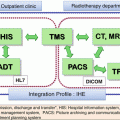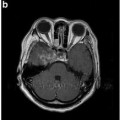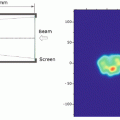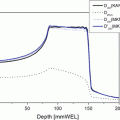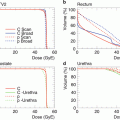Fig. 20.1
Representative dose distribution of C-ion RT for the lacrimal gland tumor at the NIRS. The current prescribed dose is 52.8 GyE in 12 fractions
Table 20.1
Summary of treatment outcomes in C-ion RT for lacrimal gland tumor at NIRS
Period | C-ion RT | Number of patients | Local recurrence | |||
|---|---|---|---|---|---|---|
Dose (GyE) | Field | Recurrence free | In-field recurrence | Marginal recurrence | ||
April 2002–March 2003 | 48.0 | Small | 5 | 3 | 1 | 1 |
April 2003–June 2005 | 52.8 | Small | 5 | 2 | 1 | 2 |
July 2005–current | 52.8 | Extended | 11 | 10 | 1 | 0 |
Total | 21 | 15 | 3 | 3 | ||
CTV with extended margins includes the inner edge, which contains the lacrimal sac; the outer edge, which is represented by the frontal bone configuring the outer orbit; the upper edge of the outer malar bone, representing the outer frontal bone with the lachrymal gland; the lower edge, which is the upper maxilla bone configuring the outer orbit; and the outside as well as the posterior edge of the malar bone, which represents the distal optic nerve before the optic chiasma. The planning target volume (PTV) is determined as a setup margin of 3 mm around the CTV.A typical dose distribution is shown in Fig. 20.1b. The eyeball, cornea, optic nerve, optic chiasma, temporal lobe of the brain, and skin are the organs at risk in the treatment planning for LGC. Since the extended margins are employed, the visual acuity of the ipsilateral eye cannot be preserved; however, it is important to decrease the dose irradiated to the cornea, iris, and ciliary body to reduce the risk of pain from keratitis or severe glaucoma. The dose to the skin and brain should also be constrained in the same manner as in the treatments for other tumors of the head and neck region (see Chap. 15; Head and Neck Tumors). The concrete dose constraints for LGC have not yet been established; however, the aim of the planning for at least one of the three fields was to spare the temporal lobe completely, and the dose to the skin was reduced using the sharp lateral fall-off of the carbon ion beam. The irradiated dose was escalated from 48.0 to 52.8 GyE in 12 fractions for the phase I/II trial at NIRS, with 52.8 GyE/12 fractions finally chosen as the recommended dose.
20.3 Up-to-Date Outcomes of the C-ion RT at NIRS
Stay updated, free articles. Join our Telegram channel

Full access? Get Clinical Tree


